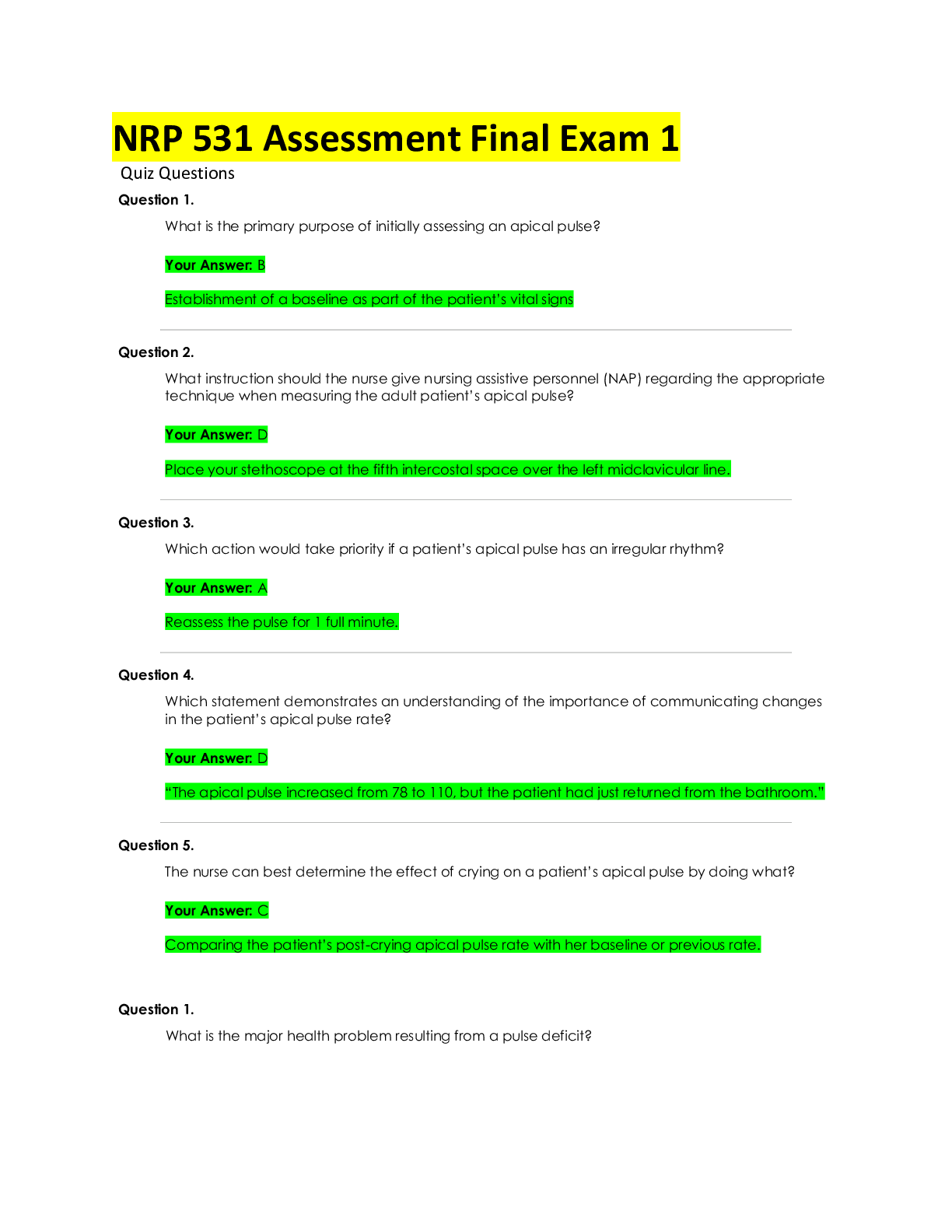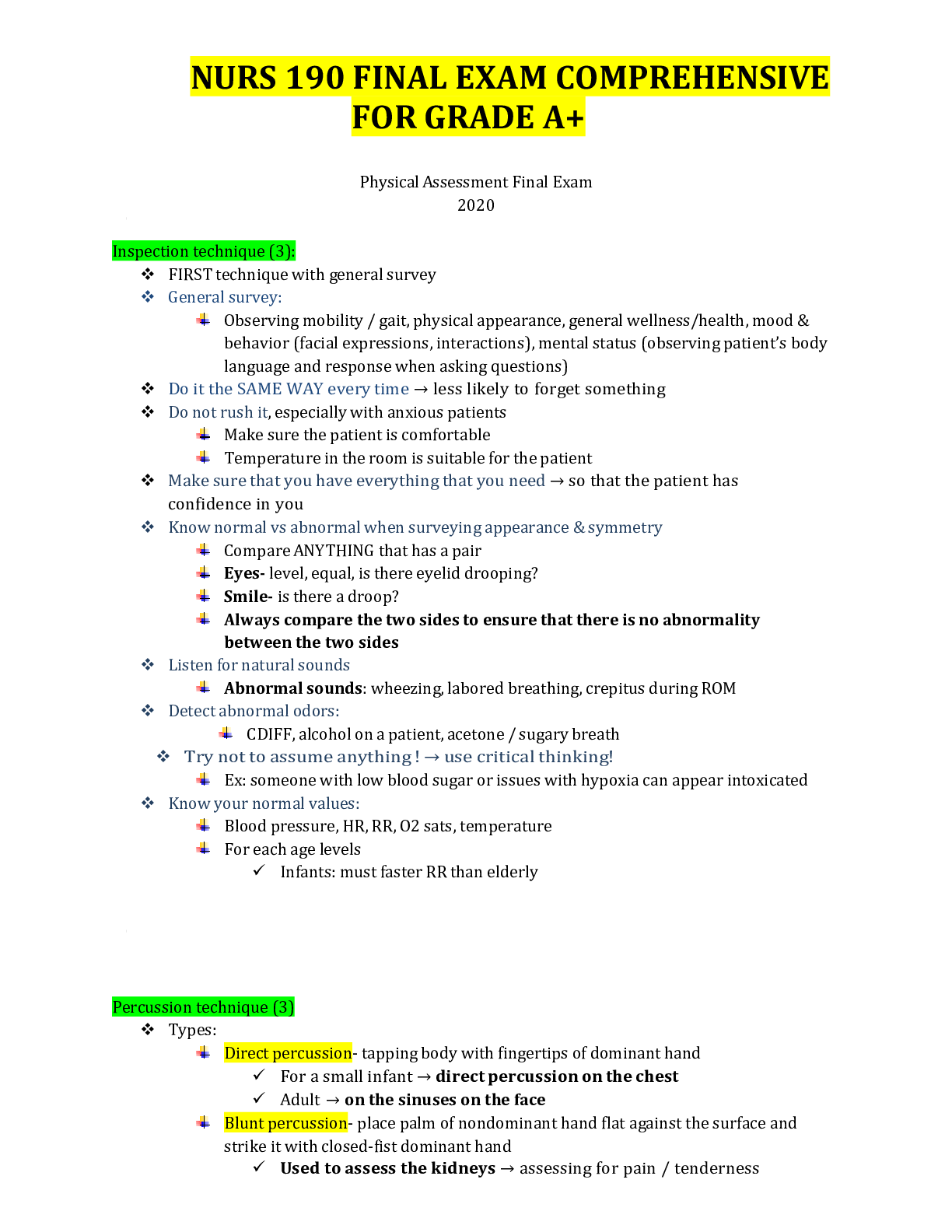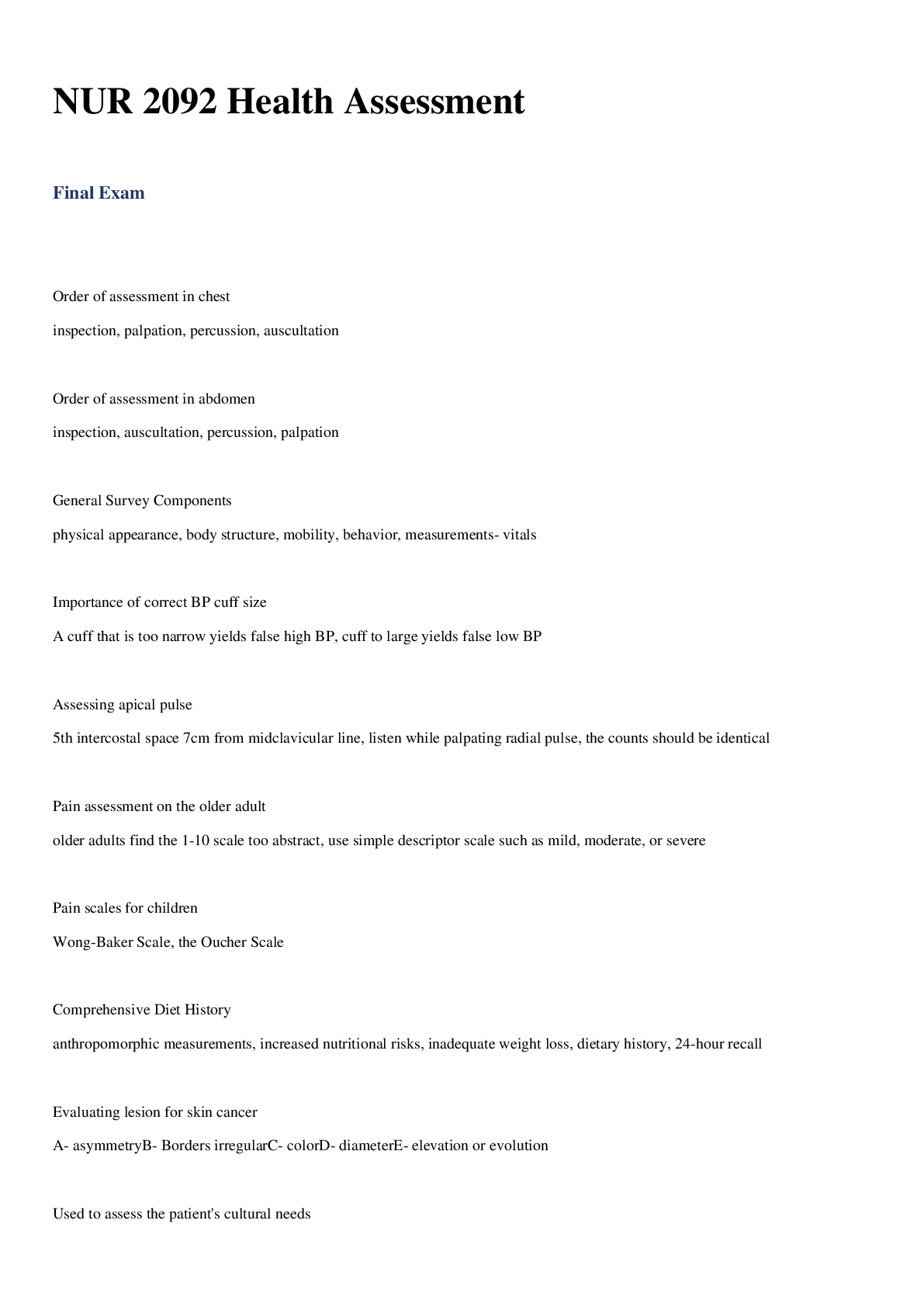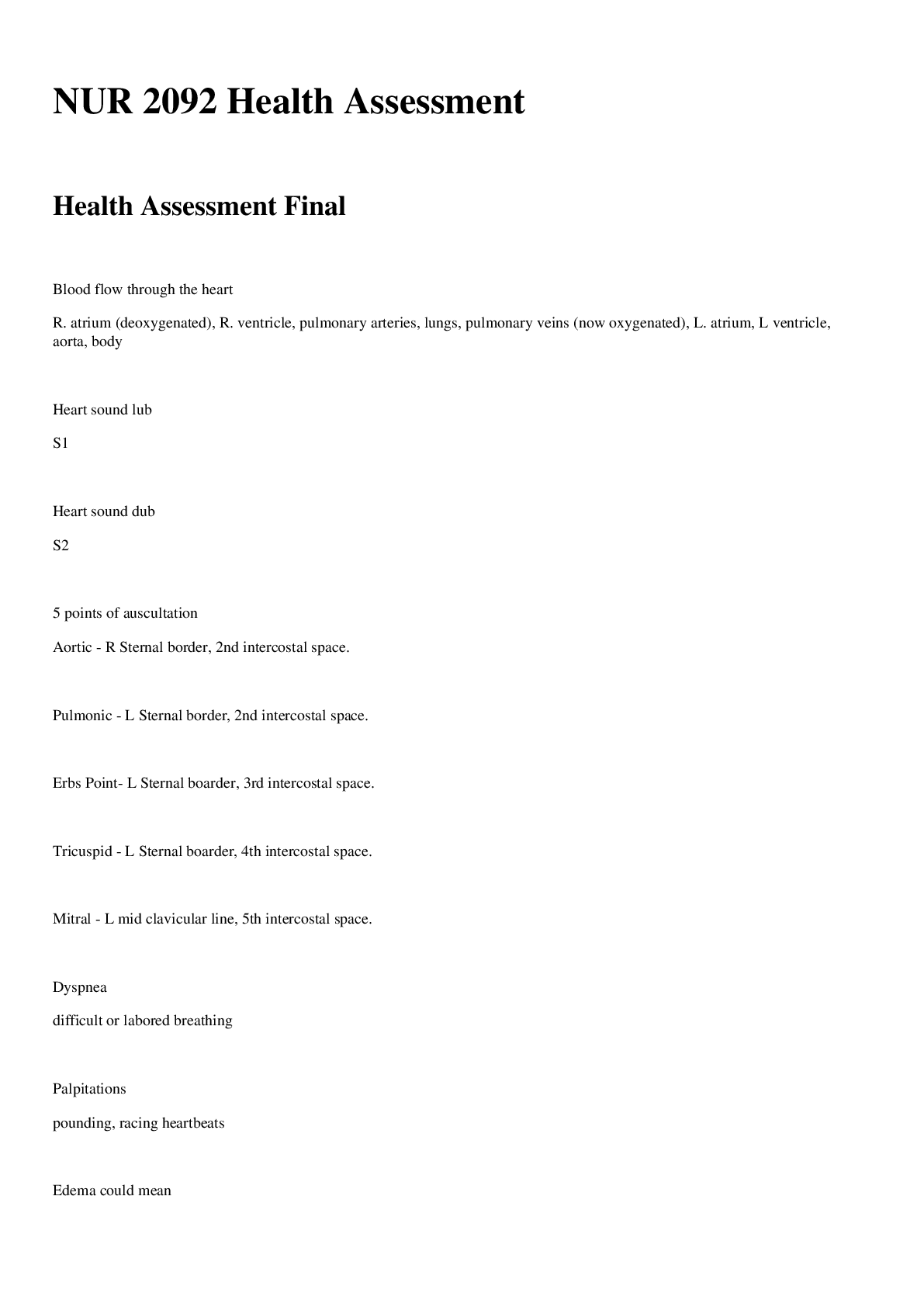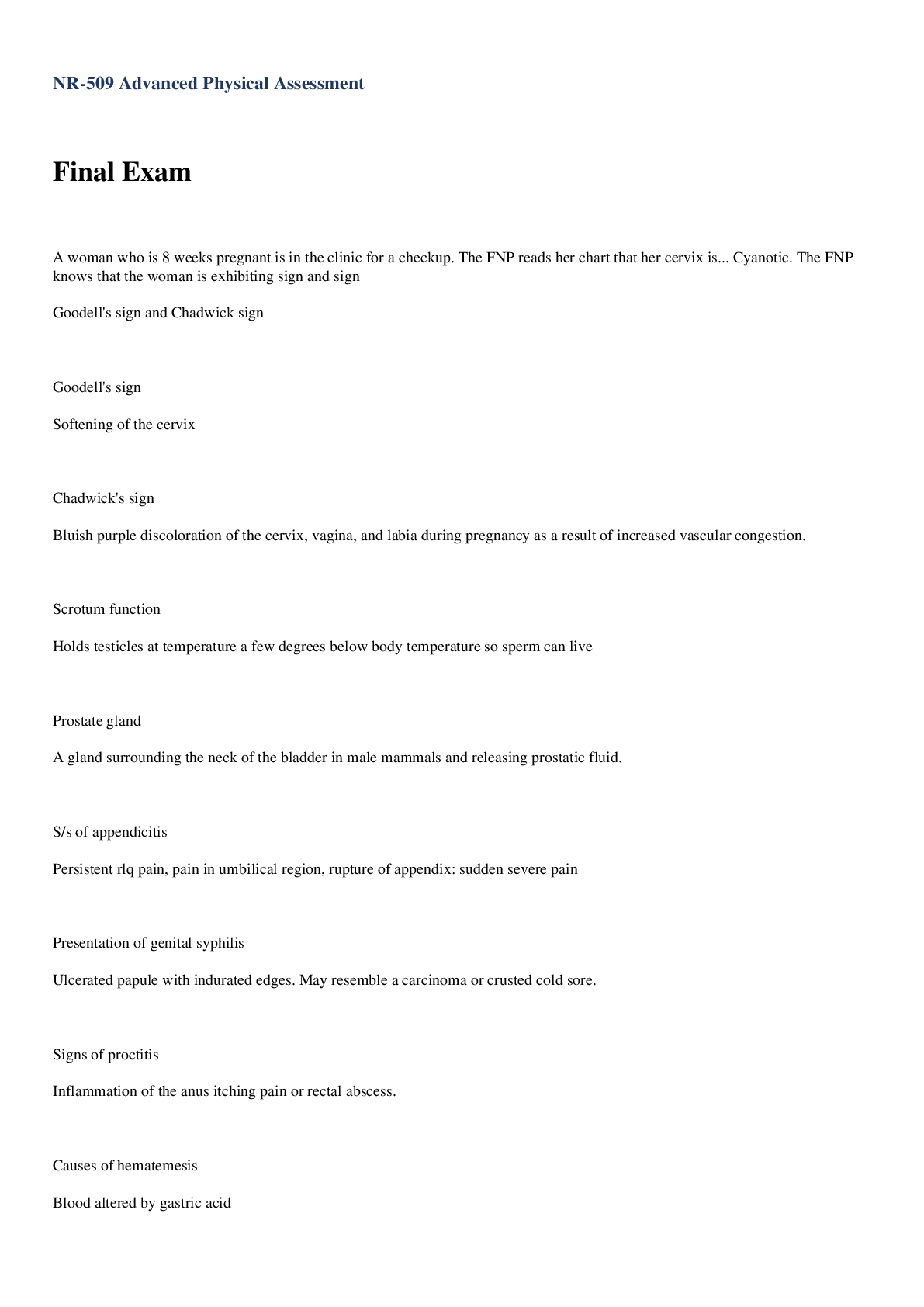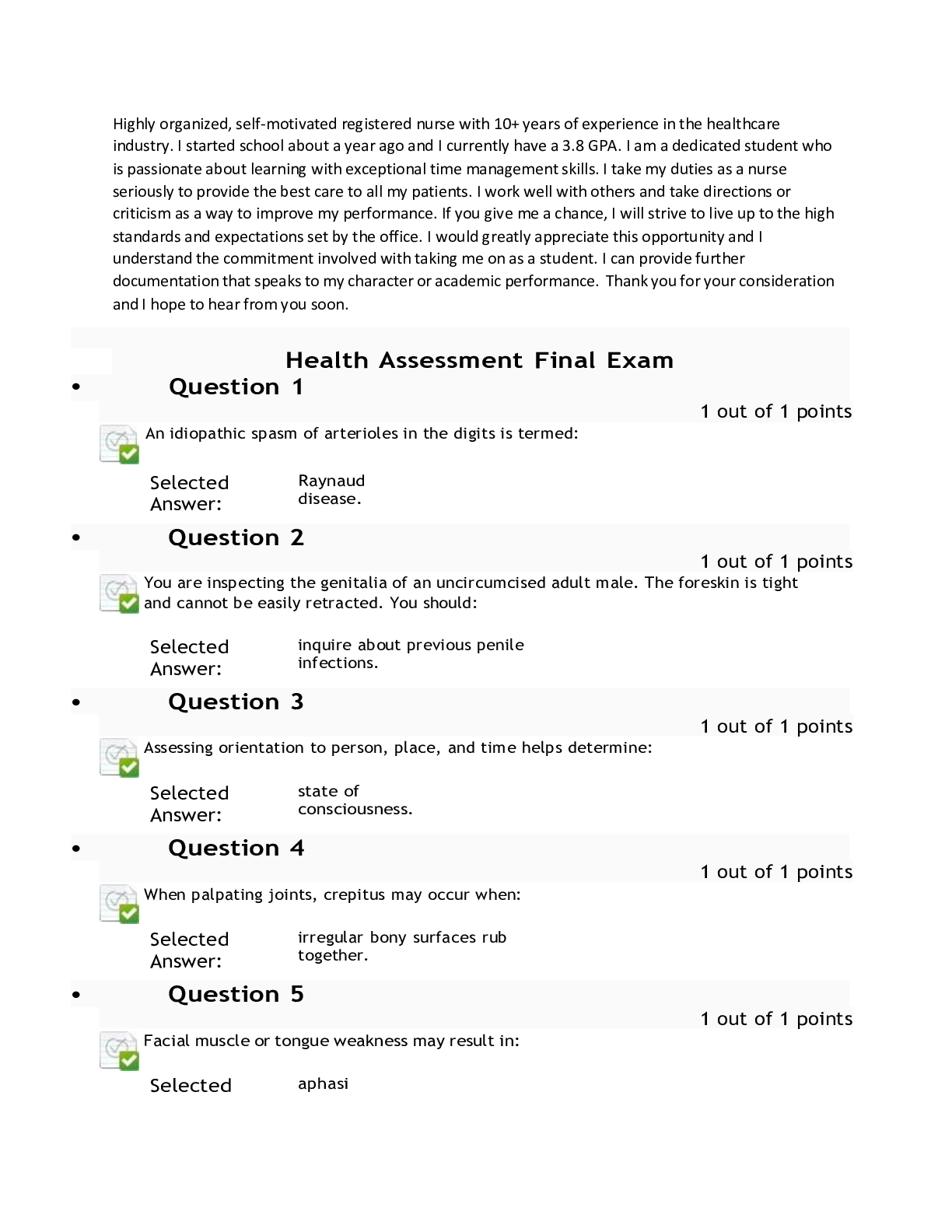*NURSING > EXAM > NURS-6512C-34/NURS-6512N-34-Advanced Health Assessment Final EXAM (Week 11) | 100% Guaranteed (All)
NURS-6512C-34/NURS-6512N-34-Advanced Health Assessment Final EXAM (Week 11) | 100% Guaranteed
Document Content and Description Below
Course NURS-6512C-34/NURS-6512N-34-Advanced Health Assessment- 2021-Summer-QTR-Term-wks-1-thru-11 Test Exam - Week 11 Status Completed When conducting a geriatric assessment, basic a... ctivities of daily living (ADLs) include: Selected Answer: bathin g. When palpating breast tissue, the examiner should use the at each site. Selected Answer: finger pads, gliding You are reviewing an ECG of a 43 year old new patient. The patient has a history of second-degree heart block. The ECG shows the PR interval is increases with each beat until a QRS is dropped. What is this type of block called? Selected Answer: Second degree heart block, type 1: Wenckebach/Mobitz 1 Throughout the history and physical examination, the clinician should: Selected Answer: evaluate the whole patient. The spread of the impulse through the ventricles (ventricular depolarization) is depicted on the ECG as the: Selected Answer: QRS complex. You are inspecting the genitalia of an uncircumcised adult male. The foreskin is tight and cannot be easily retracted. You should: Selected Answer: inquire about previous penile infections. Loss of immediate and recent memory with retention of remote memory suggests: Selected Answer: dementi a. To hear diastolic heart sounds, you should ask patients to: Selected Answer: lie on their left sides. While examining a 30-year-old woman, you note that one breast is slightly larger than the other. In response to this finding, you should: Selected Answer: note the finding in the patient's record. To spread the breast tissue evenly over the chest wall, you should ask the woman to lie supine with: Selected Answer: one arm overhead and a pillow under her shoulder. A pulsation that is diminished to the point of being barely palpable would be graded as: Selected 1 Answer: Which of the following statements is true regarding the examination of peripheral arteries? Selected Answer: The pulses are most readily felt over bony prominences. You order an ECG on a patient that c/o feeling heart palpitations, chest pain, shortness of breath. Your ECG shows irregular heart rate and you determine that you need to call EMS immediately because this rhythm can cause death. What rhythm would you suspect the ECG is showing? Selected Answer: Ventricular Tachycardia Breath sounds normally heard over the trachea are called: Selected Answer: bronchi al. The checkout station for preparticipation physical evaluation (PPE) is critical because at this point: Selected Answer: coordination of follow-ups is reviewed. Palpation of epitrochlear nodes is part of the: Selected Answer: examination of the upper extremities. A positive straight leg raise test usually indicates: Selected Answer: lumbar nerve root irritation. A chest radiography is performed on your patient that complains of having dyspnea, coughing productive sputum and chest pain. The image results shows consolidation and infiltrates. You compare this to your physical exam findings of distant or absent breath sounds and absent vocal fremitus. What is the most likely diagnosis? Selected Answer: Pneumonia The Mini-Mental State Examination: Selected Answer: may be used to quantitatively estimate cognitive changes. A 62 year old female presents to the clinic with complains of chest pain and heart palpitations that started 3 days ago. Patient states she is healthy and only has a history of hypertension and tachycardia. Patient is currently taking Norvasc 10mg daily and Coreg 6.25 mg BID. You order an EKG and it shows heart rate above 200 beats/min and the ECG may look like a sawtooth cog. What is the most likely diagnosis of this patient? Selected Answer: Atrial Flutter Anterior cruciate ligament integrity is assessed via the test. Selected Answer: straight leg raise Which one of the following techniques is used to detect a torn meniscus? Selected Answer: McMurray test Recent unilateral inversion of a previously everted nipple suggests: Selected Answer: cance r. A parent is advised to restrict contact or collision sports participation for their child. An example of a sport in which this child could participate is: Selected Answer: riflery . A common finding in markedly obese and pregnant women is: Selected Answer: lordosi s. A cervical polyp usually appears as a: Selected Answer: bright-red soft protrusion from the endocervical canal. Bimanual examination of the uterus includes: Selected Answer: grasping the cervix between the examining fingers. If your patient has nipple discharge, you will most likely need a: Selected Answer: glass slide and fixative. The foramen ovale should close: Selected Answer: within minutes of birth. You are interviewing a 20-year-old patient with a new-onset psychotic disorder. The patient is apathetic and has disturbed thoughts and language patterns. The nurse recognizes this behavior pattern as consistent with a diagnosis of: Selected Answer: schizophren ia. A patient in the deepest coma would be scored a on the Glasgow Coma Scale. Selected 3 Answer: If pitting edema is unilateral, you would suspect occlusion of a: Selected Answer: major vein. A finding that is indicative of osteoarthritis is: Selected Answer: Heberden nodes. When you attempt to move a 10-month-old child from his mother's lap to the examination table, he screams loudly. Your best action is to: Selected Answer: perform the examination while the child is in the mother's lap. The reliability of health-related findings and observations is the responsibility of the: Selected Answer: professional and the patient. Which cranial nerves are usually evaluated during the examination of the eyes? Selected Answer: III and VI An apical PMI palpated beyond the left fifth intercostal space may indicate: Selected Answer: left ventricular hypertrophy. Adrian Thompson is a 19-year-old girl who presents to the clinic with complaints of severe, acute chest pain. Her mother reports that Andrian, apart from occasional sinus infections, Andrian is not prone to respiratory problems. What potential risk factor is most important to assess with regards to Adrian's current problem? Selected Answer: Cocaine use When the Goodenough-Harris Drawing Test is administered to a child, the evaluator principally observes the: Selected Answer: presence and form of body parts. Inquiry about nocturnal muscle spasms would be most significant when taking the musculoskeletal history of: Selected Answer: older adults. An ophthalmoscopic eye examination involves: Selected Answer: lens inspection. One of the most important aspects to consider in the orthopedic screening examination is: Selected Answer: symmetr y. Examination of the patient in the lithotomy, or knee-chest, position includes: Selected Answer: palpation of anal sphincter tone. If a patient cannot shrug the shoulders against resistance, which cranial nerve (CN) requires further evaluation? Selected Answer: CN XI, spinal accessory The rectal past medical history of all patients should include inquiry about: Selected Answer: hemorrhoid surgery. Tarry black stool should make you suspect: Selected Answer: upper intestinal bleeding. Electrical activity recorded by the electrocardiogram (ECG) tracing that denotes the spread of the stimulus through the atria is the: Selected Answer: P wave. When assessing a 17-year-old for nuchal rigidity, you gently raise his head off the examination table. He involuntarily flexes his hips and knees. To confirm your suspicions associated with this positive test, you would also perform a test for the sign. Selected Answer: Kerni g Darian is a 14-year-old adolescent who states his right testicle has a soft swollen mass. The testicle is not painful upon palpation. The right inguinal canal is without masses. The mass does transilluminate with a penlight. This collection of symptoms is consistent with: Selected Answer: hydroce le While interviewing a 70-year-old female clinic patient, she tells you that she takes ginkgo biloba and St. John's wort. You make a short note to check for results of the: Selected Answer: Mini-Mental State Examination. The Mini-Mental State Examination should be administered for the patient who: Selected Answer: gets lost in her neighborhood. You are examining a patient in the emergency department who has recently sustained head trauma. In order to initially assess this patient's neurologic status, you would: Selected Answer: test the six cardinal points of gaze. During a routine prenatal visit, Ms. T. was noted as having dependent edema, varicosities of the legs, and hemorrhoids. She expressed concern about these symptoms. You explain to Ms. T. that her enlarged uterus is compressing her pelvic veins and her inferior vena cava. You would further explain that these findings: Selected Answer: are usual conditions during pregnancy. You are examining Mr. S., a 79-year-old diabetic man complaining of claudication. Which of the following physical findings is consistent with the diagnosis of arterial occlusion? Selected Answer: Loss of hair over the extremity It is especially important to test for ankle clonus if: Selected Answer: deep tendon reflexes are hyperactive. Assessing orientation to person, place, and time helps determine: Selected Answer: state of consciousness. When assessing superficial pain, touch, vibration, and position perceptions, you are testing: Selected Answer: sensory function. Kawasaki disease is suspected when assessments of a child reveal: Selected Answer: conjunctival injection, strawberry tongue, and edema of the hands and feet. Diabetic peripheral neuropathy will likely produce: Selected Answer: diminished pain sensation. The Denver II is a tool used to determine: Selected Answer: whether a child is developing as expected. A red, hot swollen joint in a 40-year-old man should lead you to suspect: Selected Answer: gou t. Your patient's chief complaint is repeated pencil-like stools. Further examination should include: Selected Answer: digital rectal examination (DRE). In the adult, the apical impulse should be most visible when the patient is in what position? Selected Answer: Uprig ht A 56-year-old male presents to the clinic to see the nurse practitioner with complaints of shortness of breath for 1 months, 15-pound weight gain and lower extremity edema. Vitals are as follows: HR: 120, Respirations 30, Blood Pressure: 138/90, BMI: 40; Oxygen saturation of 90%. On examination patient is noted to have jugular venous distention, enlarged liver, and crackles are noted on examination. A chest x-ray is completed and shows findings consistent with which diagnosis? Based on this scenario and imaging what is the most likely diagnosis? Selected Answer: Right Sided Congestive Heart Failure During chest assessment, you note the patient's voice quality while auscultating the lung fields. The voice sound is intensified, there is a nasal quality to the voice, and the e's sound like a s. This sound is indicative of: Selected Answer: lung consolidation. You are conducting a clinical breast examination for your 30-year-old patient. Her breasts are symmetrical with bilateral, multiple tender masses that are freely moveable with well-defined borders. You recognize that these symptoms and assessment findings are consistent with: Selected Answer: fibrocystic changes. When is the mental status portion of the neurologic system examination performed? Selected Answer: Constantly, throughout the entire interaction with a patient Which condition is considered progressive rather than reversible? Selected Answer: Dement ia To assess a cremasteric reflex, the examiner strokes the: Selected Answer: inner thigh and observes whether the testicle and scrotum rise on the stroked side. An idiopathic spasm of arterioles in the digits is termed: Selected Answer: Raynaud disease. Which medical condition would exclude a person from sports participation? Selected Answer: Asthm a The musculoskeletal examination should begin when: Selected Answer: the patient enters the examination room. While collecting personal and social history data from a woman complaining of breast discomfort, you should question her regarding: Selected Answer: alcohol, tobacco, and caffeine use. When palpating joints, crepitus may occur when: Selected Answer: irregular bony surfaces rub together. The presence of cervical motion tenderness may indicate: Selected Answer: pelvic inflammatory disease. Which portion of the physical examination is best done with the patient standing? Selected Answer: Spin al The goals of preparticipation sports evaluation include: Selected Answer: identifying risk of injury or death during sports participation. Facial muscle or tongue weakness may result in: Selected Answer: aphasi a. Ulnar deviation and boutonniere deformities are characteristic of: Selected rheumatoid Answer: arthritis. You are conducting an examination of Mr. Curtis's heart and blood vessels and auscultate a grade III murmur. The intensity of this murmur is: Selected Answer: moderately loud. At your first meeting with a patient, it is usually best to say: Selected Answer: "Tell me about yourself." To assess spinal levels L2, L3, and L4, which deep tendon reflex should be tested? Selected Answer: Patell ar As Mr. B. enters the room, you observe that his gait is wide based and he staggers from side to side while swaying his trunk. You would document Mr. B.'s pattern as: Selected Answer: cerebellar ataxia. Which one of the following is a proper technique for use of a speculum during a vaginal examination? Selected Answer: Press introitus downward; insert closed speculum obliquely. Breath odors may clue the examiner to certain underlying metabolic conditions. The odor of ammonia on the breath may signify: Selected Answer: diabetic ketoacidosis. You are initially evaluating the equilibrium of Ms. Q. You ask her to stand with her feet together and arms at her sides. She loses her balance. Ms. Q. has a positive: Selected Answer: Romberg sign. Part of the screening orthopedic component of the examination includes evaluating the person while he or she is: Selected Answer: duck walking. A patient you are seeing in the emergency department for chest pain is suspected of having a myocardial infarction. During the health history interview of his family history, he relates that his father had died of "heart trouble." The most important follow-up question you should pose is which of the following? Selected Answer: "What age was your father at the time of his death?" You are performing a two-point discrimination test as part of a well physical examination. The area with the ability to discern two points in the shortest distance is the: Selected Answer: fingertip s. Palpation of a normal prostate in an older adult is likely to feel: Selected Answer: rubber y. Functional assessment is most important during the examination of a(n): Selected older Answer: adult. You are assessing Mr. Z.'s fluid volume status as a result of heart failure. If your finger depresses a patient's edematous ankle to a depth of 6 mm, you should record this pitting as: Selected 3 Answer: +. Nerves that arise from the brain rather than the spinal cord are called: Selected Answer: crania l. For purposes of examination and communication of physical findings, the breast is divided into: Selected Answer: four quadrants plus a tail. The finger-to-nose test allows assessment of: Selected Answer: coordination and fine motor function. The strength of the trapezius muscle is evaluated by having the patient: Selected Answer: push her head against the examiner's hand. Your older clinic patient is being seen today as a follow-up for a 2-day history of pneumonia. The patient continues to have a productive cough, shortness of breath, and lethargy and has been spending most of the day lying in bed. You should begin the chest examination by: Selected Answer: auscultating the lung bases. The physical assessment technique most frequently used to assess joint symmetry is: Selected Answer: inspectio n. Your 15-year-old patient is athletic and thin. Radiography of an ankle injury reveals a stress fracture. You should question this patient about her: Selected Answer: menstrual cycles. A 40 yr old female presents to the clinic with complaints of low back and buttock pain. Pt states the buttock pain radiates from one side to the other. On examination, the patient is noted to have limited ROM of the shoulders, chest wall, hips, and knees. Upon xray, you find gross postural changes and there is a severe deformity of the vertebral column. What is the most likely diagnosis for this patient? Selected Answer: Herniated Lumbar Disk When completing this exam, did you comply with Walden University's Code of Conduct including the expectations for academic integrity? Selected Ye Answer: s [Show More]
Last updated: 2 years ago
Preview 1 out of 17 pages

Buy this document to get the full access instantly
Instant Download Access after purchase
Buy NowInstant download
We Accept:

Reviews( 0 )
$13.50
Can't find what you want? Try our AI powered Search
Document information
Connected school, study & course
About the document
Uploaded On
Aug 12, 2022
Number of pages
17
Written in
Additional information
This document has been written for:
Uploaded
Aug 12, 2022
Downloads
0
Views
87

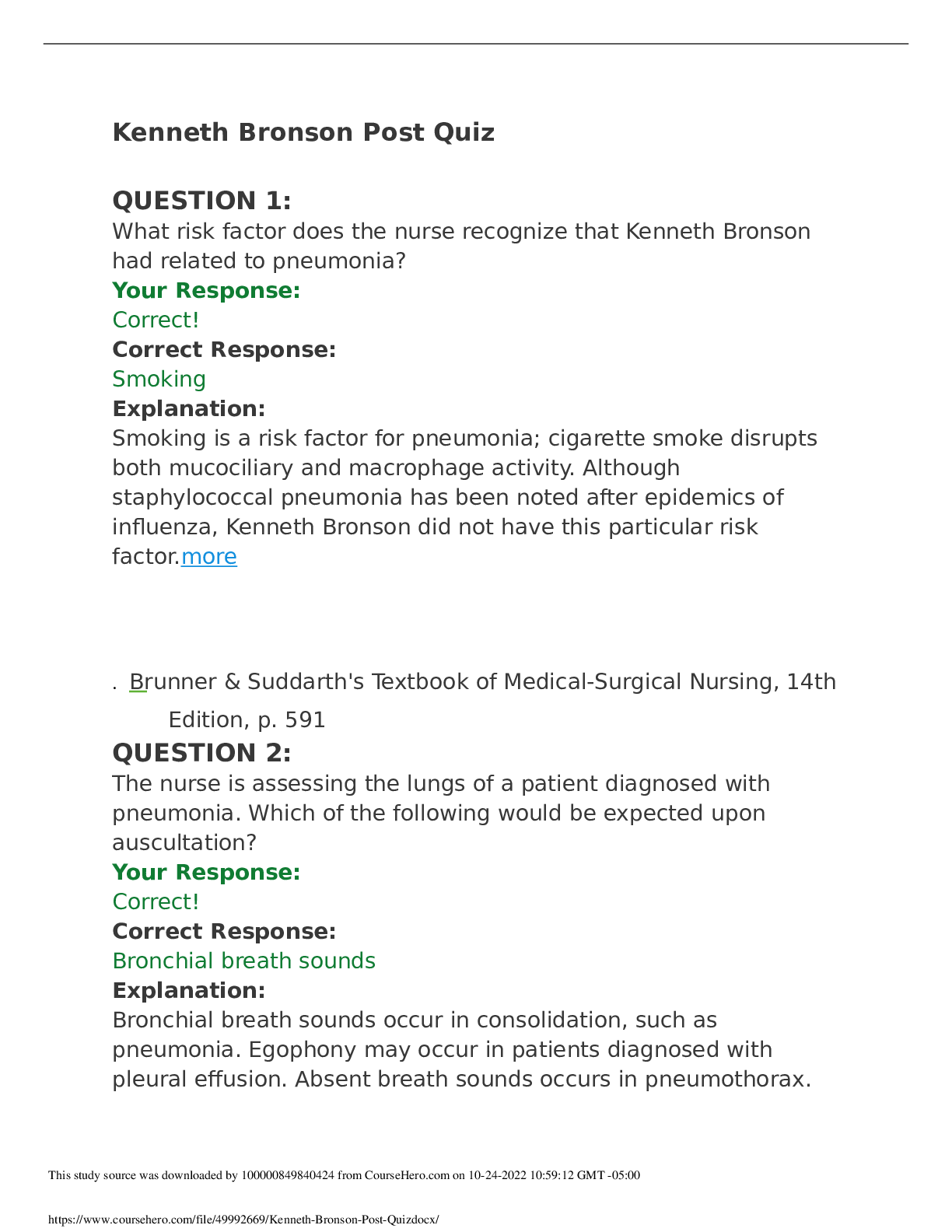



 Questions and Answers 100% VERIFIED.png)
 Questions and Answers 100% correct Solutions.png)






